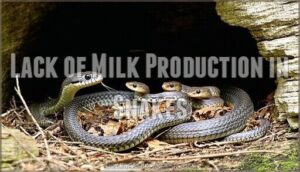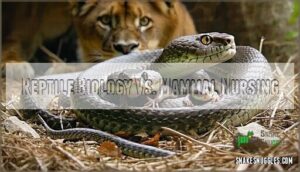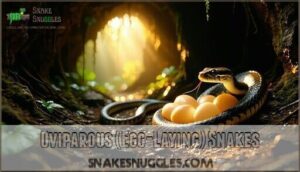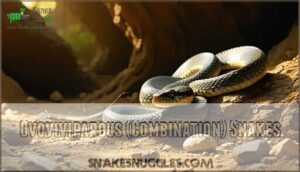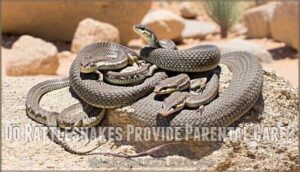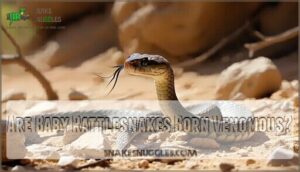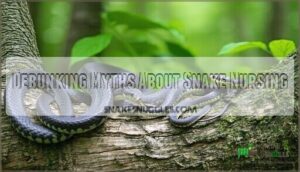This site is supported by our readers. We may earn a commission, at no cost to you, if you purchase through links.
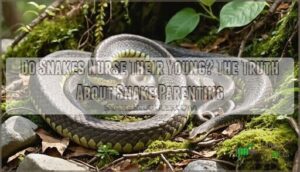
Even species like rattlesnakes that show maternal behavior only guard their babies briefly—there’s no feeding involved. Snake mothers provide protection and warmth regulation, but that’s where parental care ends. The babies are born ready to fend for themselves from day one.
Understanding how different snake species actually care for their offspring reveals some surprising behaviors that might change how you think about these fascinating reptiles.
Table Of Contents
- Key Takeaways
- Do Snakes Nurse Their Young?
- How Do Snakes Feed Their Babies?
- What Are The Birth Methods in Snakes?
- Do Rattlesnakes Provide Parental Care?
- What Do Baby Snakes Eat?
- Are Baby Rattlesnakes Born Venomous?
- Can You Milk a Rattlesnake?
- Debunking Myths About Snake Nursing
- Frequently Asked Questions (FAQs)
- Conclusion
Key Takeaways
- You can’t milk snakes like mammals – Snakes don’t have mammary glands and can’t produce milk, so nursing their young is biologically impossible.
- Baby snakes are born ready to hunt – They’re equipped with functional venom, sharp teeth, and hunting instincts from day one, needing no parental feeding.
- "Snake milking" means venom extraction – When you hear about milking snakes, it’s referring to collecting venom for medical research and antivenom production, not actual milk.
- Most snake mothers provide minimal care – While some species like rattlesnakes briefly guard their young, there’s no feeding involved – babies scatter within days to survive independently.
Do Snakes Nurse Their Young?
No, snakes don’t nurse their young like mammals do. When you think about Reptile Care and Animal Behavior, it’s important to understand that snakes lack mammary glands entirely. They simply can’t produce milk for nursing purposes.
Unlike mammals, Venomous Species like rattlesnakes and other reptiles have evolved completely different parenting strategies. Baby snakes, whether they hatch from eggs or are born live, come equipped with everything they need to survive independently. They’re born with functional teeth and hunting instincts already in place.
Baby rattlesnakes are born ready to hunt – no milk, no hand-holding, just pure survival instinct
The phrase "milk a snake" refers to venom extraction, not actual milk production. In their Wild Habitat, mother snakes provide minimal parental care compared to mammals.
Snake Nutrition works differently from the start – newborns immediately hunt small prey like insects and lizards.
This fundamental biological difference separates reptiles from mammals regarding offspring care and feeding strategies.
How Do Snakes Feed Their Babies?
If you’ve ever wondered how baby snakes get their first meals, you’re in for a surprise. Unlike mammals, snakes don’t produce milk or provide any nutritional support to their offspring after birth.
Lack of Milk Production in Snakes
Here’s your reptile biology reality check: snakes can’t produce milk because they lack mammary glands entirely. Reptile lactation simply doesn’t exist in ophidian biology. Snake nutrition works differently than mammalian nursing systems. You can’t milk a snake for sustenance—only venom extraction occurs during milking procedures.
- No specialized milk-producing tissues in snake anatomy
- Zero documented cases of snake milk production in scientific literature
- Baby snakes receive no nutritional fluids from mothers post-birth
- Venomous care involves venom extraction, not milk collection
Reptile Biology Vs. Mammal Nursing
Fundamental evolutionary differences separate reptiles from mammals in terms of offspring care. You won’t find mammary glands in any reptile – these milk-producing structures are exclusive to mammals. While mammal nursing provides essential nutrients through lactation, reptile care focuses on protection rather than feeding.
Ovoviviparous species like rattlesnakes give birth to fully independent young equipped for immediate survival, unlike mammalian babies who depend on milk for proper snake development. This distinction is rooted in the fact that mammals are endothermic mammals with unique characteristics.
Independent Feeding Behavior of Snakelets
Unlike mammals, baby snakes don’t rely on maternal feeding. You’ll find snakelets hunting independently from birth, equipped with fully functional venom systems and predatory instincts. Their neonate foraging skills kick in immediately—no hatchling care required. These juvenile survival experts locate prey through chemical detection, making Snake Parenting Behavior remarkably hands-off compared to other species.
Understanding proper baby snake feeding is essential for their growth and development.
What Are The Birth Methods in Snakes?
You’ll find that snakes use three distinct reproductive strategies to bring their young into the world.
Understanding these birth methods helps explain why snakes can’t nurse their babies like mammals do.
Oviparous (Egg-Laying) Snakes
Most egg-laying reptiles follow a straightforward Egg Laying Process. Female snakes deposit soft-shelled eggs in warm, humid locations like rotting vegetation or underground burrows. Snake Embryos develop independently during Egg Incubation, absorbing nutrients from yolk stores. Hatchling Care doesn’t exist – young snakes emerge fully independent, ready to hunt immediately. The development of snakes is influenced by their egg formation process.
Key aspects of oviparous Snake Reproduction:
- Site selection – Females choose ideal temperature and humidity conditions for Reptile Reproduction success
- Abandonment strategy – Most species leave eggs immediately after laying, providing no maternal care in snakes
- Self-sufficiency – Hatchlings possess complete hunting instincts and venom capabilities from birth
- Yolk dependency – Baby snakes survive on absorbed egg nutrients for their first week before feeding
Viviparous (Live-Bearing) Snakes
When you’re looking at viviparous species, you’ll find snakes that give birth to fully developed, live young instead of laying eggs. These reptiles develop their offspring internally through a live birth process. The mother’s body provides the perfect environment for reptile development, though she doesn’t produce milk or show typical maternal instincts.
This snake reproduction method means baby snakes emerge ready to hunt independently. Snakes that exhibit viviparous traits have evolved to thrive in challenging environments.
Ovoviviparous (Combination) Snakes
Most rattlesnakes use ovoviviparous reproduction, where eggs develop internally but don’t receive nutrients through a placenta. You’ll find this fascinating reproductive strategy combines benefits of both egg-laying and live birth methods.
- Eggs develop inside the mother’s body for approximately three months
- Young hatch from thin membranes just before or during birth
- Newborns emerge fully formed with functional venom glands and fangs
- Mothers provide no milk or mammary gland secretions after birth
Do Rattlesnakes Provide Parental Care?
You might wonder if rattlesnakes stick around to care for their babies after giving birth. While most snake species abandon their young immediately, rattlesnakes actually show some surprising maternal behaviors that set them apart from other serpents.
Maternal Behavior in Rattlesnakes
Female rattlesnakes display notable maternal instincts that challenge traditional views of reptile care. These mothers actively guard their babies, forming protective ophidian bonds through defensive posturing and physical shielding. Unlike mammals with mammary glands producing milk, rattlesnake mothers provide thermal regulation and predator deterrence.
Baby rattlesnakes benefit from this rattlesnake social behavior, huddling together while developing venom glands for independent survival after snakelet development completes.
Duration of Association With Offspring
Unlike mammals with mammary glands, rattlesnake mothers don’t stick around long after birth. Most species show minimal parental investment, with offspring dependency lasting just days or weeks. Baby rattlesnakes scatter quickly from nesting periods, as extended maternal care isn’t part of snake reproduction methods.
This brief brood duration means snake young protection relies on independence rather than prolonged parental investment.
Survival Strategies of Baby Rattlesnakes
Baby rattlesnakes hit the ground running with impressive Survival Tactics. These rattlesnake babies possess fully functional baby rattlesnake venom from birth, making them dangerous despite their size. Snakelet Growth occurs rapidly as they shed their skin within days. Baby Rattlesnake instincts drive them to seek appropriate Rattlesnake Habitat immediately.
Their Venom Resistance doesn’t exist against other predators, so Snake Young Protection relies on camouflage and staying hidden until they develop hunting skills.
The female rattlesnakes exhibit unique maternal care behaviors that set them apart from other reptiles.
What Do Baby Snakes Eat?
Since snakes don’t nurse their young like mammals do, baby snakes must find food on their own from the moment they’re born or hatch. **You’ll find that these tiny predators come equipped with all the hunting tools they need to catch prey that’s appropriately sized for their small bodies.
Diet of Newly Hatched or Born Snakes
Most snakelets plunge into carnivorous diets immediately after birth, targeting insects, small rodents, and amphibians. Baby rattlesnakes pack potent venom from day one, letting them tackle live prey like lizards and mice. Unlike milk-dependent babies in other species, these young snake foraging experts rely on high-protein neonate diet essentials for rapid growth and survival.
Understanding the baby snake’s dietary needs is vital for their development and care.
How Snakelets Hunt and Find Food
How do these tiny predators secure their first meal? Snakelets rely on instinctive hunting techniques and keen sensory abilities to locate food sources immediately after birth. Using heat-sensing pits and chemical detection, young babies employ ambush tactics as primary survival strategies.
These snake species demonstrate impressive prey capture skills, striking at small lizards, insects, and rodents. Rattlesnake behavior shows snakelets possess fully functional venom from day one, making their foraging strategies surprisingly effective despite their vulnerable size.
Baby snakes require proper feeding techniques guidance to thrive in captivity.
Nutritional Needs of Baby Rattlesnakes
Protein requirements drive everything for baby rattlesnakes during their first critical weeks. Neonate feeding focuses on small lizards and rodents that provide essential amino acids for hatchling development.
Young rattlesnakes need frequent meals—roughly every five to seven days—to fuel rapid growth. Their snakelet diet differs from adults, requiring smaller prey that matches their bite capacity and digestive abilities.
Are Baby Rattlesnakes Born Venomous?
You might wonder if baby rattlesnakes can actually hurt you since they’re so small. The surprising answer is yes—newborn rattlesnakes are born with fully functional venom glands and can deliver a dangerous bite from day one.
Venom Development in Snakelets
Remarkably, young rattlesnakes develop functional venom production systems within days of birth. Snakelet toxicity often exceeds adult levels, with concentrated neurotoxins refined for small prey.
Fang development occurs rapidly, creating efficient venom delivery mechanisms before their first hunt. These neonate bites pack serious punch—baby rattlesnake venom can be twice as potent per milligram.
Don’t underestimate venomous snake safety around juveniles.
Safety Concerns Around Young Rattlesnakes
You’ll face real danger if you encounter baby rattlesnakes in their Rattlesnake Habitat. Young babies pack a venomous punch from birth, making Venomous Species identification essential for Snake Bite Prevention. These aggressive little defenders can’t control venom delivery like adults, potentially injecting more toxin per bite.
Practice Reptile Safety by keeping your distance from any rattlesnake, regardless of size. Rattlesnake Behavior shows mothers don’t stick around long, so spotting one baby rattlesnake often means others lurk nearby.
Wildlife Conservation efforts help, but venomous snake safety starts with you staying alert.
Can You Milk a Rattlesnake?
You might wonder if you can "milk" a rattlesnake like you’d a cow, but that’s not what snake milking means.
When scientists and researchers "milk" venomous snakes, they’re actually extracting venom for medical research and antivenom production, not looking for any kind of nutritious liquid to feed babies.
What Snake Milking Means
When someone mentions "milking a snake," they’re talking about venom extraction, not actual milk. Professional snake milkers extract venom from rattlesnakes using specialized techniques that trigger the snake’s natural venom production.
This process involves carefully handling the snake and collecting the venom for medical research. Unlike mammals, snakes don’t produce milk composition – their biology focuses entirely on venom production through specialized glands.
Venom Extraction and Its Uses
Snake venom extraction provides critical medical purposes beyond simple collection. Scientists extract venom using mechanical pressure on venom glands, collecting up to 1 milliliter per session every 2-4 weeks from captive rattlesnakes.
Here are four key venom extraction applications:
- Antivenom production – Over 2 million vials manufactured annually for bite treatment
- Drug development – FDA-approved medications like captopril for blood pressure control
- Cancer research – Venom proteins studied for potential therapeutic compounds
- Pain management studies – Toxin applications help scientists understand inflammation pathways
Professional snake milkers use specialized glass containers with protective membranes. The venom extraction process requires extensive training and certification, with handlers following strict safety protocols.
Rattlesnake venom contains over 100 bioactive compounds valuable for medical uses, making this work essential for pharmaceutical advancement and saving lives worldwide. The process utilizes a Venom Extraction kit to guarantee safe handling.
Common Misconceptions About Snake Milk
When people hear "snake milk," they often picture reptile lactation like mammals. However, venomous snakes don’t produce milk for nursing. The term "milking" refers to venom extraction for research and antivenom production.
These animal misconceptions spread through fake photos and viral myths online, confusing rattlesnake biology with mammalian reproduction. Understanding the process of snake milk extraction is essential in debunking such myths.
Debunking Myths About Snake Nursing
You’ve likely seen fake photos circulating online showing snakes appearing to "nurse" their babies, but these images are digitally manipulated hoaxes.
The scientific consensus is clear: no reptile species has ever evolved the ability to produce milk or nurse their young, as this trait is exclusive to mammals.
Viral Misinformation and Fake Photos
Across various platforms, fake images claiming to show venomous snakes nursing babies spread rapidly through Social Media Misinformation networks. These Digital Deception tactics exploit people’s fascination with unusual animal behaviors.
Common Social Media Hoaxes include:
- Miscaptioned photos of snakes with unrelated animals
- Photo Manipulation showing impossible biological scenarios
- Fake News Detection challenges with convincing but false imagery
- Online Disinformation campaigns targeting wildlife misconceptions
- Viral posts lacking scientific verification or credible sources
Scientific Consensus on Reptile Parenting
Herpetologists and reptile biology experts consistently confirm that no snake species exhibits nursing behavior. Reptile care guidelines emphasize that snakelets are born self-sufficient, relying on stored yolk nutrients rather than parental feeding.
This scientific consensus on animal parenting distinguishes reptile biology from mammalian care, supporting wildlife education and wild conservation efforts through accurate species behavior understanding.
How Misinformation Spreads Online
You’ve probably seen those Facebook posts claiming mothers "milk a rattlesnake" to feed their babies. These Digital Hoaxes spread faster than wildfire through Social Media Lies and Online Rumors.
Internet Deception thrives because people share without Fact Checking. One viral PSA about snake nursing fooled thousands before experts debunked it.
Fake News Sources exploit our fascination with unusual animal behaviors.
Frequently Asked Questions (FAQs)
Do any snake species show maternal protection?
You’ll find maternal protection varies wildly among snake species, from zero-care abandoners to surprisingly devoted mothers. Pythons coil protectively around their eggs for months, while some vipers guard newborns briefly before they’re independent.
How long do baby snakes stay together?
Most baby snakes scatter within hours or days after birth, becoming independent immediately. You won’t find snake families sticking together like mammals – they’re built for solo survival from day one.
What predators threaten newborn snake survival?
Birds of prey like hawks and owls pose the greatest threat to newborn snakes. You’ll also find mammals such as foxes, raccoons, and rodents hunting vulnerable young. Even other snakes become predators, making survival challenging for defenseless hatchlings.
Do snakes recognize their own offspring?
Most snakes don’t recognize their offspring after birth. You’ll find that maternal recognition isn’t evolutionarily necessary since young snakes are born self-sufficient, with instinctive hunting abilities and venom.
Can baby snakes survive without parents?
Ever wonder how nature’s babies handle independence? You’ll find that baby snakes are born fully equipped with venom, hunting instincts, and survival skills, making them remarkably self-sufficient from day one without any parental care.
Conclusion
Understanding the truth behind "do snakes nurse their young" clears up countless myths about reptilian parenting. You’ve learned that snakes lack mammary glands and can’t produce milk, making nursing impossible. Their babies emerge fully equipped with hunting instincts and functional fangs, ready to tackle life independently.
While some species like rattlesnakes show brief maternal protection, there’s no feeding involved. These fascinating creatures prove that successful parenting doesn’t always require nurturing behaviors we associate with mammals.
- https://homework.study.com/explanation/why-do-reptiles-not-nurse-their-young.html
- http://pestanimal.com/snakefeedtheiryoung.html
- https://web.stanford.edu/group/stanfordbirds/text/essays/Parental_Care.html
- https://www.smithsonianmag.com/smart-news/study-reveals-pythons-take-care-their-offsping-little-while-180968500/
- https://www.reddit.com/r/Awwducational/comments/nncj7n/the_female_timber_rattle_snake_a_member_of_the/

